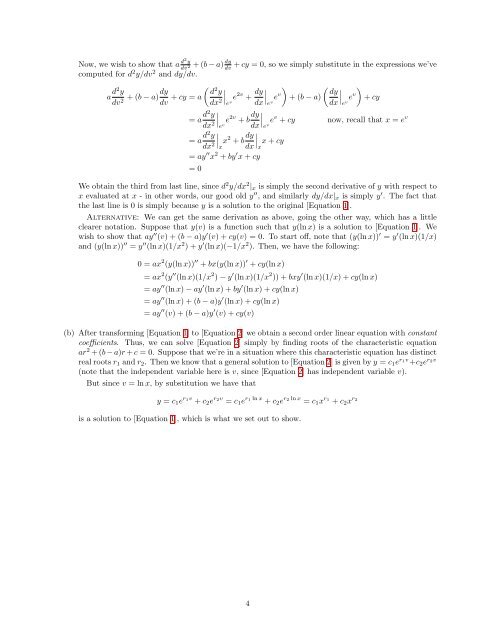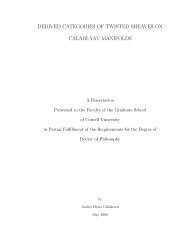Math 320 - Fall 2010 HW #7 Selected Solutions Problem 5.1.32 Let ...
Math 320 - Fall 2010 HW #7 Selected Solutions Problem 5.1.32 Let ...
Math 320 - Fall 2010 HW #7 Selected Solutions Problem 5.1.32 Let ...
Create successful ePaper yourself
Turn your PDF publications into a flip-book with our unique Google optimized e-Paper software.
Now, we wish to show that a d2y dv2 + (b − a) dy<br />
dv + cy = 0, so we simply substitute in the expressions we’ve<br />
computed for d 2 y/dv 2 and dy/dv.<br />
a d2 � 2 y<br />
d y<br />
+ (b − a)dy + cy = a<br />
dv2 dv dx2 �<br />
�<br />
� e<br />
ev 2v + dy<br />
�<br />
�<br />
� e<br />
dx ev v<br />
� �<br />
dy<br />
�<br />
�<br />
+ (b − a) � e<br />
dx ev v<br />
�<br />
+ cy<br />
= a d2y dx2 �<br />
�<br />
� e<br />
ev 2v + b dy<br />
�<br />
�<br />
�<br />
dx ev = a d2y dx2 �<br />
�<br />
� x<br />
x<br />
2 + b dy<br />
�<br />
�<br />
� x + cy<br />
dx x<br />
= ay ′′ x 2 + by ′ x + cy<br />
= 0<br />
e v + cy now, recall that x = e v<br />
We obtain the third from last line, since d 2 y/dx 2 |x is simply the second derivative of y with respect to<br />
x evaluated at x - in other words, our good old y ′′ , and similarly dy/dx|x is simply y ′ . The fact that<br />
the last line is 0 is simply because y is a solution to the original [Equation 1].<br />
Alternative: We can get the same derivation as above, going the other way, which has a little<br />
clearer notation. Suppose that y(v) is a function such that y(ln x) is a solution to [Equation 1]. We<br />
wish to show that ay ′′ (v) + (b − a)y ′ (v) + cy(v) = 0. To start off, note that (y(ln x)) ′ = y ′ (ln x)(1/x)<br />
and (y(ln x)) ′′ = y ′′ (ln x)(1/x 2 ) + y ′ (ln x)(−1/x 2 ). Then, we have the following:<br />
0 = ax 2 (y(ln x)) ′′ + bx(y(ln x)) ′ + cy(ln x)<br />
= ax 2 (y ′′ (ln x)(1/x 2 ) − y ′ (ln x)(1/x 2 )) + bxy ′ (ln x)(1/x) + cy(ln x)<br />
= ay ′′ (ln x) − ay ′ (ln x) + by ′ (ln x) + cy(ln x)<br />
= ay ′′ (ln x) + (b − a)y ′ (ln x) + cy(ln x)<br />
= ay ′′ (v) + (b − a)y ′ (v) + cy(v)<br />
(b) After transforming [Equation 1] to [Equation 2] we obtain a second order linear equation with constant<br />
coefficients. Thus, we can solve [Equation 2] simply by finding roots of the characteristic equation<br />
ar 2 + (b − a)r + c = 0. Suppose that we’re in a situation where this characteristic equation has distinct<br />
real roots r1 and r2. Then we know that a general solution to [Equation 2] is given by y = c1e r1v +c2e r2v<br />
(note that the independent variable here is v, since [Equation 2] has independent variable v).<br />
But since v = ln x, by substitution we have that<br />
y = c1e r1v + c2e r2v = c1e r1 ln x + c2e r2 ln x = c1x r1 + c2x r2<br />
is a solution to [Equation 1], which is what we set out to show.<br />
4
















